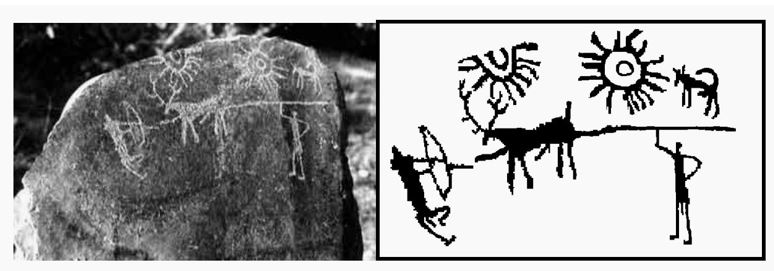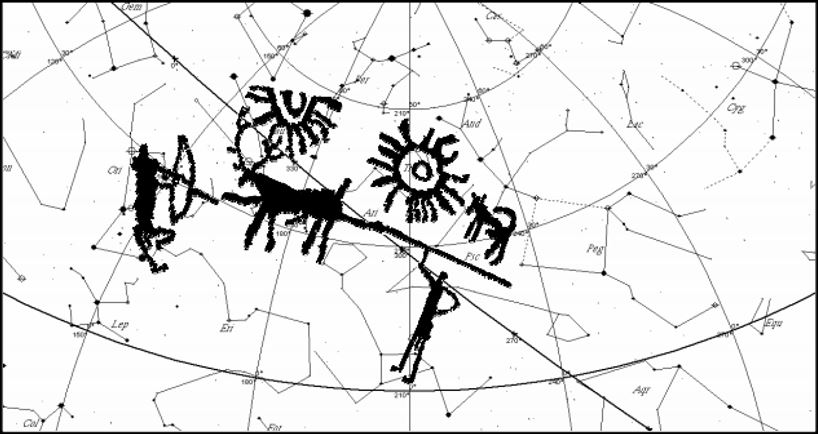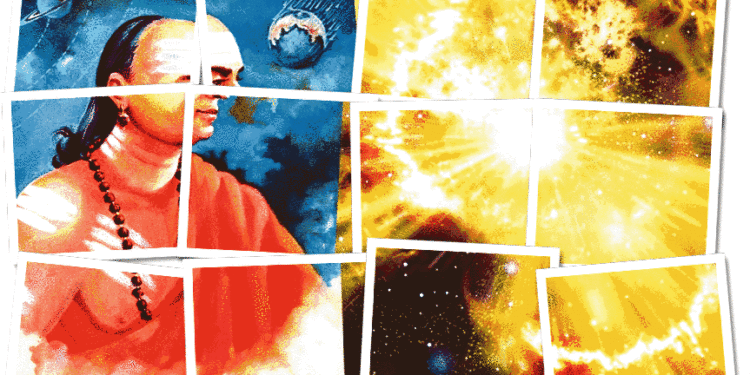Up until recently, NASA believed that it was Johannes Kepler who discovered the last observed supernova in the Milky Way in 1604. But now, a detailed study published last month in the journal of Tata Institute of Fundamental Research under the title ‘Oldest sky-chart with Supernova record’ has revealed otherwise. A team of astrophysicists including astrophysicists Hrishikesh Joglekar and M. N. Vahia, in their paper, have claimed to have unearthed a rock carving in Burzahama region in Kashmir in the Indian Subcontinent which could possibly be the oldest record of a supernova and record of the oldest sky chart ever drawn.

The carving depicts two bright objects resembling the Sun and a scene that looks like a hunting escapade. There were doubts about it being a picture of just the Sun and a moon, or another star in the sky and nothing else but after a detailed research, the scientists have removed all other speculations and hypothesis and claimed that the rock drawing is nothing else but Infact a crude picture of a supernova in the sky. In their terminology, they believe it is either G182.4+4.3 or the HB9 supernova but further calculations suggest that the supernova is likely the HB9 as it fits best with the calculations. Supernovas are bright objects in the sky visible even to naked eyes on a clear night. And since the carvings depict two full Suns, it implies that the objects would have been Infact bright like the Sun otherwise the drawing would have looked like a half moon, or a Sun with fewer spikes or something else.
But what is even more interesting is the complete Sky chart that follows the drawing. The carving shows a hunting scene as well, but Vahia have rebuked this claim and asserted that it is not a terrestrial hunting scene but actually a sky-map that is depicting the picture of the sky’s region – i.e. location of prominent constellations and the moon around HB9 on the day the supernova was observed (~5700 +- 1000 BC).

In the drawing, one of the hunters is same as the Orion; the central stag is same as the Taurus. The hunter on the right may have been formed from stars of Cetus and other animal on the right may be Andromeda and Pegasus [1]. The Team calculated the relative distances of various star locations in the figures with the angular separation of the stars in the sky suggesting that the stone drawing is a complete sky chart of the night.
Since there exists no positive identification of a supernova prior to 352 BC (Hellemans and Bunch, 1988), this stone carving predates any previous record of a supernova by far and thus is most likely be the first record of a sky map drawn to record a peculiar event [1].
It is true for all ages, that ever since humans have gained the realization to imagine and acquired the sight to look above, he has tried to look beyond the blue skies, observe, and note the wonderment of cosmic phenomenon through whatever medium was available to him – rocks, monuments or leaves. Rock carvings and cave paintings have been found dating back to ~75000 years and ~15000 years or more respectively and from female forms to human’s fascination about skies, much have found their way in stones and structures all over the world. Many pieces of evidence of such recorded observations have been found, for example, Orion (~30000 years old), Lunar ephemeris found carved in Lascaux caves (~15000 years old). And the quest to explore has only grown through time.
Today’s ‘modern’ space technologies, be it Cryogenics, Hubble or Mangalyaan, continue to push the frontiers of our imagination and discover how the universe continues to throw in our way billions of galaxies with clusters of Billions of Stars with no sign of any finite possibility.
Taking a cue from it, in hindsight, the study also invites us to ponder on the amount of information that ancient Indians had known. Now, tor a person with no appreciation towards the discoveries of ancient Indian astronomers, drawing the entire sky on a tiny piece of rock (which is only a remnant of the larger rock that is now lost to age and time) could be no astonishing feet. But there are thousands of other noted discoveries – that go back to ancient / even Vedic times – which puts all our ‘modern’ space explorations and advancements into triviality.
So, on this occasion, let us go back to that time and see a glimpse of what we have always known.
A word about ancient Indian astronomy
Long before ancient Greek’s (Hellenic) astronomical theory speculated on the shape of the Earth to be spherical, Markandeya Purana 54.12 and Rig Veda XXX. IV.V mentioned the shape of the Earth as an Oblate Spheroid – a detail unimaginable to Greeks at that time. Long before the world maps were being thought of, Ved Vyas, through a small Shloka in Bhishm Parv of Mahabharata, told how exactly the face of the world looks like. Sixty-four hundred years before Isaac Newton, Rig-Veda asserted that gravitation force holds the universe together. Long before Copernicus or Kepler talked about how Solar System might look like, Shlokas such as the ones in Rig Veda 10.149.1, Yajur Veda 33.43 [2], had the complete model of it including details about planet’s velocity, movements and elliptical orbits (not circular) and it even gives hint at how to arrive at Newton’s gravitational and angular momentum conservation laws. Scientists in 19th century England were convinced that the age of the age of the Earth was 100 million years while reading a few shlokas in Bhagwad Geeta in Chapter 9 tells you the age of the Earth to be 4.3 billion years and narrates on the age of the Universe in detail as well.
Countless scientists and Nobel laureates have been amazed at the expanse and nature that Vedic texts contain. Alexander Duff, a British historian stated that inventions and discoveries of modern Science that are considered to have emerged from Europe were actually made in India several centuries ago. “Amazing isn’t it Vedas and Puranas are divine sources of knowledge” said Dr. Donald Mitchell of the Johns Hopkins Applied Physics Laboratory. “It is hard to believe that these facts were already mentioned in Hindu books thousands of years back, in the time when we humans here didn’t know much about Astronomy.” [3]
Even much finer yet modern astronomical and astrophysical details like existence of equinoxes and polar nature of days and nights (Rig Veda), formation of planets and natural satellites (Brahmand Puran), scattering of sunlight (Markandeya Purana 78.8), Moon’s non luminous nature (Atharva Samhita), origin of the Universe, its movement, expansion and contraction (Srimad Bhagwatam) (the still debatable Big bang and the Big crunch theories of the universe came out of these texts and Suktas like Hiranyagarbha), composition of the Sun light (Rig Veda), eclipse cycles, multiverse theories (Bhagawat Purana 6.16.37), absence of an absolute reference frame/nothing is immovable in the universe (Sam Veda), mention of Protective Layer Ozone (Shrimad Bhagwatam) among thousand other facts of the modern world have been elucidated in these texts centuries and centuries ago. And not just in Astronomy, diverse modern ideas related to Geography and Geology, from account of the tides (Vishnu Puran) to description of tectonic plates, Value of Pie [4] in mathematics to the development of Embryo (Srimad Bhagavatam 3.31.1) that we now know today using the most advanced technologies at our disposal, were known to ancient Indians in details like the back of their hand.
But there is no need to elaborate on that. Quite simply, the fact is that everything, from astrological predictions to astronomical discoveries, from architectural to political science, from art of navigation to fine arts (detailed in NatyaShastra), from Medical, Physical and Chemical Sciences to Economic and Psychology, from Metaphysics to Spirituality; Or to be precise from laws that govern our body to cosmic laws that govern this universe, that we know today using the combined capacity of all our modern technologies pales into insignificance when compared to the sight that ancient sages and Rishis had while sitting in their ashrams dong Mediations and observing samadhies. Many Scientists and philosophers agree that the cyclic nature of time puts Vedic age as the most advanced and enlightened age and all the discoveries of today’s age, anywhere across the globe, owes something to it. To an open mind, Vedic wisdom is not some classified Hinduism text or religious doctrines, it is the universal storehouse of facts and scientific treatise that contains the seed of all forms of knowledge – spiritual or material.
But a question arises here, ancient Indian astronomers have no telescope or technologies to observe the sky, then how it was possible for them to record observations happening millions of light years away. Here’s a short answer to begin with.
न तु मां शक्यसे द्रष्टुमनेनैव स्वचक्षुषा |
दिव्यं ददामि ते चक्षु: पश्य मे योगमैश्वरम्
-(11.8, Shri Bhagwad Geeta)
To achieve any kind of feat, certain discipline and tools are required. You cannot point a microscope towards the skies to discover new stars, or use a telescope to explore the micro world. For example, to gain heights in spirituality, you need renunciation, to achieve the eternal benefits of Yoga, you need ‘Dhyaan’ / Meditation and so forth. Simply putting, to see something, you need the right kind of eyes. But to see something without the need to look at it, you need vision. The Rishis and Sages were Infact ‘Spiritual scientists’ with a vision to see things as they are without the need to actually look at them using tools or telescopes or maps. They never needed them. If you can close your eyes, meditate upon a star, and know, not just its position in the sky, but how it looks like, you don’t need a Hubble Telescope. A fine example of it is the well-known twin star-system – called Arundhati-Vashistha [5].
Infact, one of the causes for supernova formation is a combination of stars called Binary stars (or twin star system) that orbit around their common barycenter and it is only until recently that advance research in astrophysics have revealed that half or more of visible stars are actually part of such star systems (like Sirius, and Cygnus X-1) [6] NASA’s uses it Hubble, one of the most advanced Science project in Modern history, and Chandra X-ray Observatory to observe such cosmic events [7]. But, even such an advanced feat was known to Indian Rishis when they held that a successful marriage relation between a husband and a wife should look like the twin stars called Arundhati-Vashistha – orbiting around each other in the sky. They not only knew about the location of these stars in the sky, about their barycenter movement, but also symbolized it to guide humanity on the path to a successful marriage (and the fact that it is ‘Arundhati-Vashistha’ and not ‘Vashistha-Arundhati’ symbolizes that Sanatana Dharma always held women higher in respect than men).
This spiritual vision, that no material advancement has ever been able to achieve, is the only reason possible why Tulsidas, one of the greatest poet and soul ever lived, was able tell the distance between the Sun and the Earth with an accuracy that NASA has confirmed after spending billions of dollars in Sun Exploratory missions, through just a small couplet in Hanuman Chalisa. Astrology, a science that is based on the position of the stars and planets vis-a-vis zodiac constellations and the other stars (nakshatras) in the sky at the time of your birth, to predict your future, stems from this vision and is the only explanation possible that allowed Maharishi Vishwamitra, a great astronomer and astrologer, to predict the exile of Lord Rama in a conspiracy by his own trusted people. This same vision granted the boon to Maharishi Valmiki to write down an epic like Ramayana even before it happened.
Now, for many this may all sound a ‘myopic-opinion’ made to glorify ancient Indian achievements. No doubt, we have become more scientific and less spiritual and which is neither good nor bad for change is the only thing that permeates everything else. But what good a change is if we forget the roots from where we have come while Americans and Germans established Sanskrit schools to learn the language in order to decipher the hidden treasures of Vedic wisdom. What good a change is if we need someone else, for example, to tell us what Sanskrit could achieve for us. We borrow our own pride only when ‘Einstein’ credits us for the zero without which no mathematics/physics is possible, we need an Oppenheimer (considered the father of atomic bomb) to tell us that atoms and their stored atomic energies were discovered by Indian sages long back.
We have been fed with western and European charm all our lives by Leftist historians but had we been busy looking and exploring our own wisdom and not try to stand on the shoulders of someone else, articles like these won’t be necessary at all today.
References
[1] Oldest sky-chart with Supernova record. Hrishikesh Joglekar, Kavita Gangal, M N Vahia, Aniket Sule
http://www.tifr.res.in/~vahia/oldest-sn.pdf
[2] https://truthabouthinduism.wordpress.com/2013/12/20/response-to-science-in-vedas-2/
[4] http://www.sanskritimagazine.com/vedic_science/value-pi-upto-32-decimals-rig-veda/
[5] https://en.wikipedia.org/wiki/Mizar_and_Alcor
[6] Filippenko, Alex, Understanding the Universe (of The Great Courses on DVD), USA, 2007.
[7] https://www.nasa.gov/audience/forstudents/5-8/features/nasa-knows/what-is-a-superova.html






























